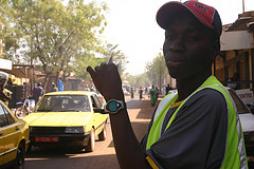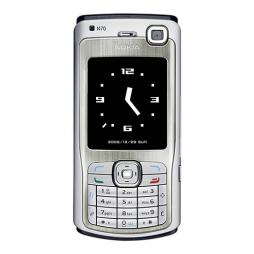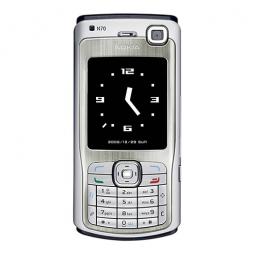m-banking
Posted by BrettMeyer on Aug 15, 2007
In the West African nation of Mali, back street vendors power the mobile phone market. The major players -- Ikatel, a division of France Telecom, along with the homegrown Malitel -- have official stores, but most of their sales come from the street. In West Africa, subscription service is rare. Instead, mobile phone users purchase plastic-wrapped cards of varying denominations, scratch off a silvery bar much like those found on an instant lottery ticket, and recharge their phones with the code hidden underneath. These cards can be purchased from tin-roofed convenience shacks, egg sandwich vendors, or random men walking down the street, stacks of soccer jerseys slung over their shoulders.
Posted by AnneryanHeatwole on Feb 07, 2011
Today's Mobile Minute brings you coverage on how the Egyptian government shut down the country's Internet and mobile services, work-arounds for communicating during a government-ordered Internet blackout, problems with keeping customers engaged in mobile banking and payment services, Android's new place as the top-selling mobile operating system in the world, and a prediction for huge increases in mobile data traffic by 2015.
- In the aftermath of the Egyptian telecommunications blackout, ArsTechnica looked at both how the Egyptian government managed to limit the country's communications so effectively (mainly through ordering major ISPs and Telcos to shut off service) and if a government-mandated Internet/mobile lockdown could be recreated in other countries. In related news, Wired.com has created a wiki on how to communicate if the government limits/shuts down Internet access.
- Vodafone announced that the Egyptian government invoked emergency powers and forced it and the other telcom providers in Egypt to send pro-government text messages to Egyptian subscribers. In a press release, Vodafone claims that the messages were not scripted by Vodafone, and that although they protested the government's involvement, they "do not have the ability to respond to the authorities on their content." Since then, a much-nedeed debate has begun on the responsibility of telcoms to resist this interference.
Posted by AnneryanHeatwole on Jan 27, 2011
The Mobile Minute is back to bring you the latest in mobile and development news! Today we have coverage on what 4G really means, the rise of videos on mobile devices, Vodafone's launch of m-banking services in India, a breakdown of what sort of data and research is missing in a lot of conversations about the impact of mobile devices in the developing world, and why you should password protect and encrypt your smart phone.
- NPR has an interview with Engadget's Chris Ziegler, who explains why some 3G technologies are being marketed as 4G and how these new networks differ from traditional 3G. He also covers the benefits of market competition, hindrances to fast wireless broadband access, and why 2011 will be the year of the smartphone in the U.S..
- The growth of video viewing on mobile devices (Poynter reports that "more than 200 million YouTube videos are viewed on mobile devices each day") has led to a huge jump in the mobile advertising market as advertisers try to reach out to new viewer, resulting in expectations of a $1 billion mobile advertising market for 2011.
Posted by AnneryanHeatwole on Oct 05, 2010
Today's Mobile Minute is focused on mobile money. We've got news about Bharti's financial services in India, Rwanda's new mobile banking guidelines, Digicel's plan for mobile financial services in Haiti, ICT growth from 1998 to 2009, and the popularity of native apps on smartphones.
- Digicel, a Caribbean telecom, announced they will launch a mobile banking pilot project in Haiti, starting this October. The pilot will allow users to transfer funds and give and receive cash via mobiles.
- ICT4Dblog charted how ICTs have grown around the world, ranking mobile, Internet, and broadband growth over an 11-year period. The site then looked at how these numbers show the digital gap between rich and poor countries, and then reported on: "digital lag: the time gap between a given average ICT penetration level in the poorest countries, and the year that was achieved in the richest countries. Current digital lag is just under 10 years for mobile, and something like 14-15 years for Internet. For broadband, it’s just over 10 years but the figures are so low that this may not be meaningful."
[Mobile Minute Disclaimer: The Mobile Minute is a quick round-up of interesting stories that have come across our RSS and Twitter feeds to keep you informed of the rapid pace of innovation. Read them and enjoy them, but know that we have not deeply investigated these news items. For more in-depth information about the ever-growing field of mobile tech for social change, check out our blog posts, white papers and research, how-tos, and case studies.]
Image courtesy Flickr user QiFei
Posted by MohiniBhavsar on Jul 27, 2010
The Innovative Use of Mobile Applications in East Africa data sheet 3644 Views
Author:
Johan, Hellstrom; Swedish International Development Cooperation Agency
Abstract:
The Swedish International Development and Cooperation Agency (Sida) recently published a report that gives an overview of the current state of mobile phone applications for social and economic developments in East Africa. Drawing on successful adoption of mobile applications in the Philippines, this Sida report seeks to answer “what hinders the take off of m-applications for development in East Africa and what role donors play in the process.” While mobile phones is the one of the most widely accessible gateways for information in East Africa, with mobile penetration covering over 40% of the population, sustainable, scalable mobile services for social and economic development are limited. The report is supported by secondary data, statistics, and field work carried out in Kenya, Rwanda and Tanzania, along with numerous interviews, meetings and discussions with key stakeholders in East Africa. Major trends in mobile usage, barriers for increased use of m-applications, as well as opportunities for scaling are discussed.
Posted by AnneryanHeatwole on Mar 12, 2010
Mobile Banking: Overview of Regulatory Framework in Emerging Markets data sheet 3894 Views
Abstract:
Across developing countries, millions of people rely on informal economic activity and local level networks to earn their living. Most of these populations are from bottom of pyramid and they don’t have access to basic financial services/banks as access to them is costly and very limited. However, the outstanding growth of mobile sector worldwide has created a unique opportunity to provide social and financial services over the mobile network. With over 4 billion mobile cellular subscriptions worldwide, mobile network has the ability to immediately offer mobile banking to 61% of the world population. A study states the biggest share of mobile payment users will be in the Asia/Pacific region by 2012 (Gartner, 2008). In the context of being the most promising ICT market and the largest inbound remittance receiver, this region is expected to be the hub of m-banking transactions.
The paper starts with an overview of existing models of m-banking and then examines the m-banking regulations in some South Asian countries and of the countries where (e.g. the Philippines, Kenya, South Africa) m-baking/payment systems are already in practice or a success. The concerns of financial regulators and policy measures taken so far are discussed.
The key questions this paper aims to answer:
⇒ What are the practiced models of m-banking/payment systems?
⇒ What concerns are generally raised by financial regulators?
⇒ Which m-banking/payment models have drafted or enacted in South Asia?
⇒ Which m-banking/payment models have are enacted in the countries where it is a success?
⇒ What constitutes a proportionate regulatory approach?
The answers to the above questions helps to identify a way forward which can expedite adoption of m-banking/ payments service in South Asia successfully and quickly.
Posted by AnneryanHeatwole on Nov 30, 2009
Mobile-Banking Adoption and Usage by Low-Literate, Low-Income Users in the Developing World data sheet 4146 Views
Author:
Indrani Medhi, Aishwarya Ratan, Kentaro Toyama
Abstract:
Due to the increasing penetration of mobile phones even in poor communities, mobile-phone-enabled banking (m-banking) services are being increasingly targeted at the “unbanked” to bring formal financial services to the poor. Research in understanding actual usage and adoption by this target population, though, is sparse. There appear to be a number of issues which prevent low-income, low-literate populations from meaningfully adopting and using existing m-banking services.
This paper examines variations across countries in adoption and usage of existing m-banking services by low-literate, low-income individuals and possible factors responsible for the same. It is observed that variations are along several parameters: household type, services adopted, pace of uptake, frequency of usage, and ease of use. Each of these observations is followed by a set of explanatory factors that mediate adoption and usage.
Posted by AnneryanHeatwole on Oct 23, 2009
Mobile Phones for Development and Profit: A Win-Win Scenario data sheet 3100 Views
Abstract:
The number of mobile subscribers globally is estimated to have reached four billion in 2008 (ITU, 2008), with mobile penetration reaching 61%. Around 58% of subscribers are in developing countries, and subscriber growth in Africa – more than 50% per year – is the highest in the world. Studies have shown that this rapid increase in mobile penetration has contributed significantly to economic growth. Fuss, Meschi and Waverman (2005) looked at 92 countries, both developed and developing, to estimate the impact of mobile phones on economic growth for the period 1980 to 2003. They found that a 10% difference in mobile penetration levels over the entire sample period implies a 0.6% difference in growth rates between otherwise identical developing nations. The effect of mobiles was twice as large in developing countries as in developed ones (Waverman, 2005).
Mobile phones have brought three kinds of benefits (id21, 2007). First, incremental benefits, improving what people already do – offering them faster and cheaper communication, often substituting for costly and risky journeys. Fishermen in India, for example, can earn more money and waste less fish by phoning coastal markets to see which market has a shortage of supply. Second, transformational benefits that offer something new. Innovative applications, such as m-banking and m-commerce, are bringing banking services to millions for the first time, and enabling people to use mobile phones to pay for goods and services. Third, production benefits that result from the creation of new livelihoods, not only through professional telecommunications jobs but also through activities like re-selling air-time or phone cards. Since the liberalisation of Nigeria’s telecommunications sector in 2000, the industry has become a key source of new jobs in the economy, employing about 5,500 professionals, and responsible, indirectly, for another 450,000 jobs.
Posted by AnneryanHeatwole on Oct 08, 2009
M-Banking the Unbanked data sheet 1784 Views
Author:
Alex Comninos, Steve Esselaar, Ali Ndiwalana, Christoph Stork
Abstract:
While the role of the informal sector in promoting economic growth in Africa is increasingly acknowledged, access to capital remains one of the biggest obstacles hindering the development and growth of the sector (Stork & Esselaar, 2006). Africa is struggling with access to formal financial services for its citizens and the informal sector. In addition to the underlying structural limitations of poverty; risk-averse bankers, unsuitable financial products and high bank charges have also been blamed for this state of affairs.
Poor people with irregular income and informal businesses often have no choice but to make use of informal financial services, which are many times more expensive than formal ones. Formal financial services are usually only extended to those with regular income or collateral (Firpo, 2008). Informal businesses also often lack the required accounting skills and systems to generate necessary data to convince a bank to extend loans to them.
Other obstacles include the bureaucratic and educational bottlenecks that prevent many Africans from having identity documents. This fosters corruption around documents such as birth certificates, IDs and passports, increasing the risk for banks in dealing with new customers.
A critical issue to overcome is that of asymmetrical information. Someone without a bank account approaching a bank for a loan is likely to be rejected unless collateral is at hand. The bank has no transaction history for this person or informal business and hence does not know anything about the applicant’s creditworthiness. Transaction patterns can be used to predict whether or not a customer will be able to repay a loan. Absence of a transaction history means that the ability to repay loans is unknown to banks, making it risky for banks to serve such a person unless the loan is fully collateralised.
Few individuals in the informal sector have access to collateral. They either have their own informal small businesses (such as street vendors) or work on an ad hoc basis. Mobile banking (m-banking) can be seen as one solution to these problems. Despite having been around for some time in several African countries, the existing offerings are mostly value-added services – where the mobile phone is a complimentary channel to operating an existing bank account. Such services are not geared towards the inclusion of the poor and unbanked, and while they are growing in popularity, they have yet to shift the access frontier in order to become “transformational” (Porteus, 2007).
To become transformational, m-banking must progress towards bringing more informal businesses and the poor into the formal economy so that they are better able to access micro-loans and other financial services. Transacting on a mobile payment platform can also generate a transaction history that can act as a basis to evaluate creditworthiness. This would address the inadequate access to finance that restricts the entrepreneurial potential of Africa's informal sector and the poor.
This paper seeks to explore how the ubiquitous mobile platform may be leveraged to move beyond simple transactions and provide an alternative banking system that provides access to formal financial services to the unbanked. This can be achieved by using applications that facilitate transactions over mobiles, which go beyond the& usual voice communications, and the money or airtime transfers.
Posted by sharakarasic on Oct 28, 2008
On the first day of MobileActive ’08 in Johannesburg, I attended "M-Banking and M-Payments for Social Impact", with Jonathan Donner, Tonny Omwansa, Jesse Moore, Brian Richardson, and Alex Comninos presenting to a packed room. The session gave an overview of m-banking (mobile banking) and m-payments (mobile payments), including specific mobile banking solutions such as M-PESA and Wizzit.
Brian Richardson, the CEO of Wizzit, began by stressing that mobile banking is becoming more and more common in African countries. In South Africa, more than 11 million people live with cash only. 600 million in Africa don’t have access to basic financial services because of affordability, accessibility, and availability. Without access to basic financial services, it’s hard to be an economic citizen.
Posted by Simon Pavitt on Feb 23, 2008
There's a great article about spread of mobile phones in India and Africa on the BBC News website.
For instance, it mentions how migrant Zimbabwean workers in South Africa send money back using M-banking and avoid having to pay bribes to border guards when they go home.




